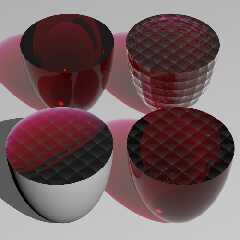|
 |
On 3/24/25 13:24, Cousin Ricky wrote:
> The obvious solution, especially if we're creating a macro that can vary
> the wine's pour level, is to intersect the top of the wine with a
> material that has the normal; but for some reason, this kills the
> interior color. The result is at the lower left.
It's always been the case that the interior{} intersections must be
'clean' for the fade_* features to work correctly.
Meaning, for the fading calculations there cannot be terminating or
intervening surfaces unrelated to those forming an interior region.
Your case is, I believe, more complicated in that by referencing the
'material' wrap of a texture{} and interior{} for the plane in the
intersection for the lower left case, you've created a situation where
two different interior{} definitions are seen (that they are identical
doesn't matter) which are attached to two different transparent surfaces.
Where the starting and stopping intersections are on different surfaces
with respect to the attached interiors, no fading calculations get done.
Attached is an image where for the lower left case I changed:
hollow
material { m_Wine }
to:
hollow
texture { pigment {rgb 1 } }
This makes the fade calculation for interior attached to the plane in
the intersection 'clean'. Not what you want of course, but yep...
Bill P.
Post a reply to this message
Attachments:
Download 'cricky.png' (158 KB)
Preview of image 'cricky.png'

|
 |




![]()